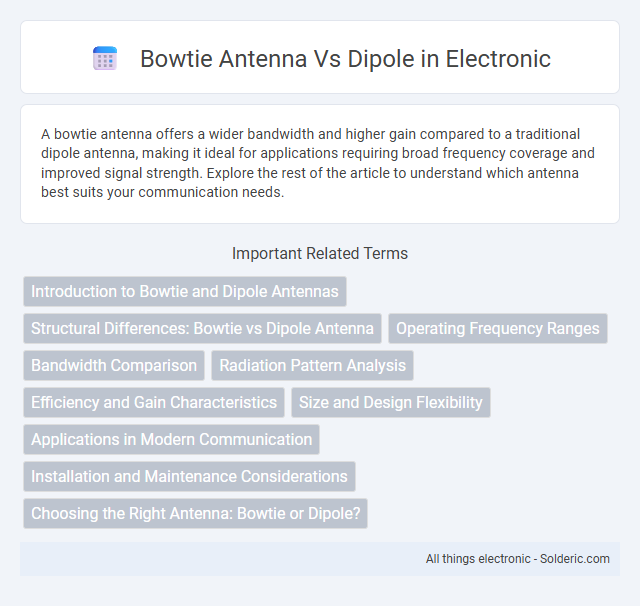A bowtie antenna offers a wider bandwidth and higher gain compared to a traditional dipole antenna, making it ideal for applications requiring broad frequency coverage and improved signal strength. Explore the rest of the article to understand which antenna best suits your communication needs.
Comparison Table
| Feature | Bowtie Antenna | Dipole Antenna |
|---|---|---|
| Structure | Two triangular metal plates forming a bowtie shape | Two straight metal rods aligned end-to-end |
| Bandwidth | Wide bandwidth, typically several GHz | Narrow bandwidth, typically a few MHz |
| Radiation Pattern | Broad, directional pattern with moderate gain | Omnidirectional in the plane perpendicular to elements |
| Frequency Range | Ultra-wideband (UWB) capabilities | Single or narrow frequency band |
| Impedance | Approximately 300 O, can be matched to 50 O with balun | About 73 O in free space |
| Applications | Ultra-wideband communication, radar, TV antennas | Radio broadcasting, amateur radio, base stations |
| Size | Compact, size depends on lowest frequency | Half-wavelength per element |
| Polarization | Linear, typically horizontal or vertical | Linear, horizontal or vertical |
Introduction to Bowtie and Dipole Antennas
Bowtie antennas feature a wide, triangular shape that provides broad bandwidth and higher gain compared to traditional dipole antennas, which consist of two straight conductive elements. Dipole antennas are simple, efficient, and widely used for a variety of communication applications, making them ideal for narrowband frequency ranges. Your choice between bowtie and dipole antennas depends on the desired frequency range and bandwidth requirements for optimal performance.
Structural Differences: Bowtie vs Dipole Antenna
The bowtie antenna features a wide, triangular planar structure that provides broadband frequency response, unlike the dipole antenna's simple, straight-wire design with two equal-length arms. The bowtie's expanded surface area improves impedance matching and enhances signal reception over a broader range of frequencies, while the dipole's thin wires limit its operational bandwidth. Understanding these structural differences helps you select the appropriate antenna for applications requiring broad frequency coverage or narrowband performance.
Operating Frequency Ranges
Bowtie antennas typically operate efficiently over a broader frequency range, often spanning from VHF to UHF bands, making them ideal for wideband applications. Dipole antennas usually have a narrower operating frequency band centered around their resonant frequency, which limits their effectiveness to specific frequency ranges unless modified. Your choice depends on whether you require broadband performance or targeted frequency operation for effective signal transmission and reception.
Bandwidth Comparison
Bowtie antennas exhibit significantly wider bandwidth compared to traditional dipole antennas, making them ideal for applications requiring broad frequency coverage. Their triangular shape allows for efficient multi-frequency performance, whereas dipole antennas typically have narrow bandwidth centered around a specific resonant frequency. Choosing a bowtie antenna can enhance Your system's ability to operate effectively across diverse frequency bands without retuning.
Radiation Pattern Analysis
Bowtie antennas exhibit a broad radiation pattern with wide bandwidth and strong directional characteristics, ideal for ultra-wideband applications. Dipole antennas produce a figure-eight radiation pattern with uniform coverage in the plane perpendicular to the antenna, offering consistent performance in narrowband scenarios. Analyzing your specific radiation pattern needs helps determine whether the bowtie's wide angle and frequency range or the dipole's stable, simpler pattern is more suitable.
Efficiency and Gain Characteristics
Bowtie antennas exhibit higher bandwidth and better efficiency across ultra-wide frequency ranges compared to dipole antennas, which tend to have narrower bandwidth and moderate efficiency. The gain of a bowtie antenna is typically more uniform over its operational frequency, with values commonly ranging from 4 to 6 dBi, whereas dipole antennas generally offer a peak gain around 2.15 dBi but can outperform bowtie antennas at specific, narrow frequency bands. Efficiency in bowtie antennas benefits from their broad radiating structure that reduces reactive losses, making them preferable for wideband applications requiring consistent gain.
Size and Design Flexibility
Bowtie antennas offer greater design flexibility and compact size compared to traditional dipole antennas, making them ideal for broadband applications where space is limited. Their triangular shape allows for easy scaling and integration into portable devices while maintaining efficient performance across a wide frequency range. Your choice between a bowtie and dipole antenna depends on the specific size constraints and bandwidth requirements of your project.
Applications in Modern Communication
Bowtie antennas excel in broadband applications such as television broadcasting and ultra-wideband communication due to their wide frequency response and simple structure. Dipole antennas are widely used in point-to-point and mobile communication systems where narrowband performance and easy impedance matching are crucial. Your choice between these antennas depends on the required frequency range, bandwidth, and specific communication application.
Installation and Maintenance Considerations
Bowtie antennas feature a wideband design that simplifies installation by requiring fewer adjustments for optimal performance compared to dipole antennas, which often need precise tuning and alignment. Maintenance for bowtie antennas tends to be less frequent due to their robust construction and fewer components, while dipole antennas may require more regular inspections and retuning to maintain signal quality. Your choice should consider the ease of installation and ongoing maintenance needs to ensure reliable operation over time.
Choosing the Right Antenna: Bowtie or Dipole?
Bowtie antennas offer a wider bandwidth and higher gain, making them ideal for UHF television reception and applications requiring broad frequency coverage. Dipole antennas are simpler, cost-effective, and provide reliable performance in narrowband scenarios, particularly for FM radio and VHF frequencies. Selecting between bowtie and dipole antennas depends on specific frequency range, gain requirements, and installation constraints.
bowtie antenna vs dipole Infographic

 solderic.com
solderic.com